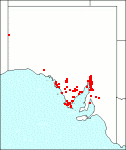Family: Malvaceae
Alyogyne huegelii
Citation:
Fryx., Proc. Linn. Soc. N.S.W. 92:265 (1968).
Synonymy: Hibiscus huegelii Endl., Enum. Pl. Hügel 10 (1837); H. drummondii sensu J. Black, Fl. S. Aust. 566 (1952); H. huegelii Endl. var. leptochlamys Benth., Fl. Aust. 1:217 (1863); H. wrayae Lindley, Edwards' Bot. Reg. 26:t. 69 (1840); H. huegelii Endl. var. wrayae (Lindley)Benth., Fl. Aust. 1:217 (1863).
Common name: Lilac hibiscus.
Description:
Erect shrub 1-2 m high; tomentose with short stellate hairs; leaves deeply palmately 3-5-lobed, undulate, usually suborbicular in outline, 1.5-3 (sometimes to 5)cm long, with obovate or oblong (or rarely lanceolate) pinnatifid or coarsely toothed obtuse lobes, green on both surfaces; petioles 5-30 mm long.
Peduncles solitary, usually longer than the leaves, 4-70 mm long; epicalyx of 7-10 unequal linear or subulate lobes 4-10 mm long, up to one-third of the length of the calyx, divided to the base or fused to form a cup at the base; calyx 18-25 mm long, tomentose or villus, deeply divided into 5 lanceolate-acuminate 3-5-nerved lobes; petals violet or purple, not more deeply coloured at the base, 4.5-7 cm long, 1-toothed at the upper outer edge, softly stellate-tomentose or villous on the undersurface; style branches connate; stigmas subsessile, fusiform, spreading stellately.
Capsule ovoid-globose, shorter than the calyx, tomentose or villous, containing numerous subglabrous seeds.
Published illustration:
Costermans (1981) Native trees and shrubs of south-eastern Australia, p. 224.
|
Conservation status:
native
Flowering time: June — Jan.
|

SA Distribution Map based
on current data relating to
specimens held in the
State Herbarium of South Australia
|
Biology:
No text
Taxonomic notes:
While the taxonomy of the varieties formerly recognised has not been investigated for this treatment, it appears that Fryxell (1968) did not recognise them. Similarly, the identity of the entity referred by Black (1952) to H. drummondii requires examination.
Author:
Not yet available
|

